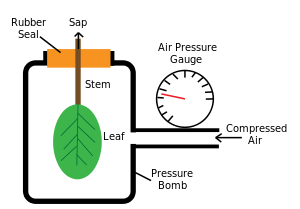Pressure bomb

A diagram showing the setup of a Pressure bomb
A pressure bomb or pressure chamber or Scholander bomb is an instrument with which it is possible to measure the approximate water potential of plant tissues. A leaf attached to a stem is placed inside a sealed chamber and pressurised gas is added to the chamber slowly. As the pressure increases at some point sap will be forced out of the xylem and will be visible at the cut end of the stem. The pressure that is required to do so is equal and opposite to the water potential of the leaf.[1][2]
References
- ↑ http://jxb.oxfordjournals.org/cgi/content/abstract/23/1/267 1972 Journal of Experimental Botany - The Measurement of the Turgor Pressure and the Water Relations of Plants by the Pressure-bomb Technique M. T. TYREE and H. T. HAMMEL
- ↑ Scholander, P.; Bradstreet, E.; Hemmingsen, E.; Hammel, H. (1965). "Sap Pressure in Vascular Plants: Negative hydrostatic pressure can be measured in plants". Science 148 (3668): 339–346. Bibcode:1965Sci...148..339S. doi:10.1126/science.148.3668.339. PMID 17832103.